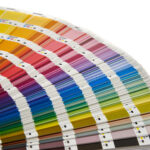Chromium Oxide Green Applications in Refractories Explained.
Did you know that about 80% of the world’s chromium output is used for producing refractories? Chromium oxide green, scientifically known as Cr2O3, is remarkable for its unique features. These qualities render it crucial in applications involving high heat. It boosts strength and resistance to oxidation in various industrial processes.
This write-up will delve into the broad applications of chromium oxide green in refractory materials. We will emphasize its role in modern industry. Let’s discover why this adaptable compound is so essential.
Introduction to Chromium Oxide Green
Green chromium oxide is a bright green substance renowned for its versatility and durability. It is important in the sector of refractories due to its distinct features. This material goes beyond boosting the visual appeal of manufactured goods, but also provides notable industrial gains for exacting industrial uses.
In the refractory industry, chromium oxide green plays a pivotal role. It boosts the high-temperature resistance and durability of substances in extreme environments. This includes applications in iron and steel industries and glass manufacturing. As companies advance, the material’s significance increases, delivering benefits for high-temperature scenarios where endurance is essential.
Green chromium oxide is not only a color additive; it’s a critical element for durable heavy-duty tasks. Its flexibility and robustness render it a key ingredient in the manufacture of durable refractory materials.
Grasping Chromium Oxide and its Structure
Green chromium oxide, also referred to Cr2O3, is a compound made up of chromium and oxygen atoms. Its chromium oxide composition showcases special characteristics that enhance its application across various sectors. This compound’s chemical structure is solid and stable, delivering endurance in challenging environments.
The refractory properties of chromium oxide stand out in uses requiring compounds that can endure intense thermal conditions. It demonstrates a robust capacity to endure temperature fluctuations. This turns it into ideal for refining and other industrial processes where heat is important.
Comprehending the details of the makeup of chromium oxide aids industries utilize its natural advantages. Its capacity to resist stress improves overall efficiency. This places chromium oxide as a preferred option among refractory materials.
Significance of Chromium Trioxide in Refractory Applications
Chromium trioxide is vital for the effectiveness of refractory materials because of its special qualities. It enhances the reliability and durability of these compounds in challenging settings. This insight is crucial for grasping its position alongside chromium oxide in a range of uses.
Role of Chromium Trioxide in Enhancing Stability
Refractory materials must withstand high temperatures without losing integrity. Chromium trioxide enhances their thermal resistance and internal strength. This results in less deterioration, making it vital for companies demanding reliable substances.
Side-by-Side Evaluation of Chromium Oxide and Chromium Trioxide
Chromium oxide and chromium trioxide have unique contributions in refractory compounds. Both are key, but vary in their qualities:
| Feature | Chromium Oxide | Trioxide of Chromium |
|---|---|---|
| Thermal Stability | Good thermal stability | Boosted heat resistance |
| Use | Commonly used in refractory materials | Suited for extreme heat conditions |
| Longevity | Average strength | Significantly boosts durability |
This comparison shows the specific strengths of green chromium oxide and chromium trioxide to refractory materials. Their different characteristics boost effectiveness and durability in different industries.
Thermal Endurance Features of Green Chromium Oxide
Green chromium oxide exhibits exceptional traits, rendering it ideal for high-temperature applications. Its melting point goes up to very high heat levels, providing exceptional reliability in extreme conditions. This is vital for sectors demanding strength, especially in metalworking industries.
Fusion Temperature and Build Quality
Green chromium oxide is renowned for its high melting point, crucial for preserving refractory structural integrity. This heat tolerance lets it tolerate extreme heat without losing shape. Its heat resistance makes it essential in environments requiring reliability.
Applications in Steel Smelting
In metalworking, green chromium oxide’s high-temperature resistance is crucial. It’s often applied in thermal-resistant building blocks for kilns and heat chambers. These bricks are subjected to harsh heat and must remain intact. Chromium oxide green’s thermal endurance makes them effective, improving efficiency in metalworking.
Advantages of Green Chromium Oxide in Refractories
Chromium oxide green significantly enhances heat-resistant products, vital for multiple sectors. It boosts mechanical properties and resistance to oxidation. These improvements increase the durability and performance of refractory products.
Enhancing Structural Traits
Incorporating chromium oxide into refractory materials notably boosts their structural qualities. Main advantages involve:
- Enhanced toughness: Green chromium oxide’s strength boosts the longevity of substances against damage.
- Greater resistance to abrasion: Its makeup lowers the impact of usage from intensive use, lengthening the lifespan of materials.
- Enhanced structural resilience: This trait allows heat-resistant materials to resist external forces, fitting exacting uses.
Resistance to Oxidation in Heat-Intensive Uses
Green chromium oxide’s resistance to oxidizing conditions is essential in high-temperature environments. The advantages are:
- Increased durability: Thermal-resistant substances endure more, enduring harsh environments.
- Improved functionality: They undergo less wear and tear, allowing for consistent performance in sectors.
- Minimized replacement needs: Less need for substitution of materials reduces expenses for refractory-dependent operations.
These green chromium oxide gains improve the durability of heat-resistant materials and support sustainability. They extend service life and reduce waste.
Understanding the Uses of Chromium Oxide Green in Refractories
Green chromium oxide has grown essential in various fields due to its exceptional features. It is effective in numerous fields, from steelmaking to ceramics manufacturing. Its role as a key ingredient in refractory materials shows its value.
Industrial Uses
Chromium oxide green is crucial in various fields for better performance. Here are the key sectors and their particular applications:
- Metal Manufacturing: It’s used in making refractory bricks and thermal-resistant castables, providing thermal stability and abrasion resistance.
- Glass Manufacturing: In refractory linings, it ensures intense heat and provides resistance to chemical reactions.
- Ceramics Manufacturing: As a dye in ceramic finishes, it provides coloration, robustness, and material strength.
- Cement Industry: It enhances the features of refractory materials for intense thermal applications.
Multiple Applications of Refractory Materials
Chromium oxide green’s versatility extends beyond one field. Its applications span a wide range, for example:
- Thermal-resistant brick applications
- Moldable refractory materials for harsh environments
- Furnace coatings to prevent corrosion
- Heat-resistant ceramics
This broad application spectrum demonstrates green chromium oxide’s significance in improving manufacturing processes. Its exceptional features assist sectors achieve their operational goals, ensuring improved output and long-lasting products.
Primary Sectors for Green Chromium Oxide
Green chromium oxide is crucial in various industries, recognized for its versatility and efficiency. It is mainly used in the refractory industry, improving thermal stability and mechanical strength. This compound is critical in materials designed for harsh environments.
In the production of heat-resistant bricks and coatings, green chromium oxide is notable. These products are vital in extreme heat environments like kilns, furnaces, and incinerators. Adding chromium oxide green improves their effectiveness, promising they endure more and offer dependable use.
- Ceramics: Green chromium oxide is vital in pottery, enhancing color stability and structural integrity.
- Metallurgy: It is used in metal refining for instruments and items demanding thermal durability.
- Glass Manufacturing: In glass production, chromium oxide green guarantees the durability of glassmaking chambers.
This compound is important not just in traditional uses but also in innovative materials. The push for eco-friendly practices is encouraging its use in next-generation heat-resistant compounds.
As sectors focus on performance and effectiveness, green chromium oxide proves indispensable. Its extensive versatility emphasizes its value across multiple fields. This proves its significance in the modern refractory industry.
Methods of Producing Chromium Oxide Green
The manufacture of green chromium oxide uses various proven methods, each with distinct benefits and drawbacks. These approaches are crucial for creating high-purity chromium oxide green, necessary for its diverse roles. Methods such as combustion, water-based, and precipitation are key in production and output reliability.
Standard Production Techniques
Many typical manufacturing processes are utilized in green chromium oxide manufacture. These comprise:
- Combustion Method: This method entails the ignition of chromium salts with carbon-based substances. It is efficient and has a low environmental impact.
- Aqueous Process: This method employs the reaction of chromium compounds in an water-based mixture under elevated pressure and thermal conditions. It creates finely structured materials.
- Settling Technique: This process requires the solid formation of chromium compounds from water-based suspensions. It enables regulation over the size of particles and morphology.
Each process provides distinct benefits, such as affordability and expandability, but also comes with issues like refinement and size inconsistency. Choosing the appropriate process significantly impacts the quality of the end product and its suitability for specific applications.
Maintaining Standards in Chromium Oxide Green Production
Quality control is crucial in the creation of green chromium oxide. It guarantees the end result meets industry standards for cleanliness and consistency. Main factors to monitor consist of:
- Regular testing of starting compounds to maintain material quality for manufacturing chromium oxide green.
- Control of manufacturing conditions, such as thermal levels and compression, during the various manufacturing techniques.
- Produced material evaluation for chemical composition and characteristics, ensuring compliance with desired specifications.
Reliable monitoring techniques enhance the trustworthiness and efficiency of chromium oxide green for its wide-ranging roles. This underscores the vital nature of these production techniques in the entire production chain.
Sustainability in the Production and Use of Chromium Oxide Green
The push for sustainability is reshaping the chromium oxide green industry. Eco-conscious efforts is now a primary focus as manufacturers pursue strategies to lower environmental impact. By incorporating sustainable practices, they reduce emissions and reduce resource consumption.
Integrating sustainability into the manufacturing of green chromium oxide aligns with environmental regulations and market expectations. Companies are now more conscious of their effects on the planet. By using advanced processes, they enjoy benefits such as:
- Employing recycled substances in manufacturing, which minimizes new resource extraction.
- Boosting energy efficiency in creating products.
- Enhancing recycling practices to lessen damage to the environment.
Chromium oxide green’s sustainable use is also obvious in various sectors. For instance, it is instrumental in emission reduction systems, minimizing hazardous gases. This proves the importance of environmental responsibility in the sector of heat-resistant materials.
| Practice | Explanation | Environmental Benefit |
|---|---|---|
| Resource Utilization | Utilizing by-products in creation | Minimizes raw material extraction |
| Power Consumption | Techniques to lower energy consumption | Reduces energy-related emissions |
| Emission Control | Incorporating pollution control technology | Lessens harmful pollutants released |
| Waste Minimization | Optimizing waste recycling processes | Minimizes material waste |
As companies focus on sustainability, the manufacture of green chromium oxide and use become crucial. They demonstrate how green practices and forward-thinking processes can collaborate, paving the way for a greener future.
Advancements in Refractory Uses of Chromium Oxide Green
The field of heat-resistant material use is set for major changes, notably with progress in green chromium oxide use. As sectors prioritize efficiency and sustainability, the next phase of this compound becomes increasingly crucial.
Developing methods are driving innovation in chromium oxide green’s applications, which may involve:
- Better temperature endurance for enhanced functionality in challenging settings.
- New formulations that increase its role in metallurgy and clay-based products.
- Next-generation production processes to minimize ecological footprint while ensuring product consistency.
The incorporation of green chromium oxide into new heat-resistant materials guarantees strong results for sectors worldwide. Ongoing innovation and study will harness this material’s special features. This promises it remains crucial in cutting-edge refractory technology.
By capitalizing on these breakthroughs, industries can boost the efficiency and eco-friendliness of their thermal-resistant solutions. This guarantees a future of chromium oxide green extremely bright.
Summary
Chromium oxide green is a key compound that improves the durability and effectiveness of heat-resistant materials across various fields. Its exceptional properties, such as thermal tolerance and resistance to oxidation, are important for the steel industry and ceramics production.
The analysis of chromium oxide green’s roles demonstrates its adaptability and importance in current industrial needs. Ongoing innovations in manufacture enhance its potential, guaranteeing it stays important for demanding roles.
As the movement for greener practices expands, the use of chromium oxide green is likely to expand. Its involvement in developing green heat-resistant products highlights its vital role in the modern refractory industry. This promises improved performance and productivity in a rapidly evolving manufacturing landscape.


